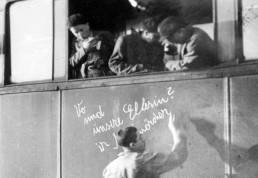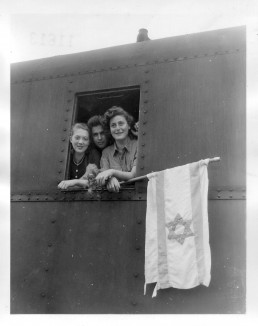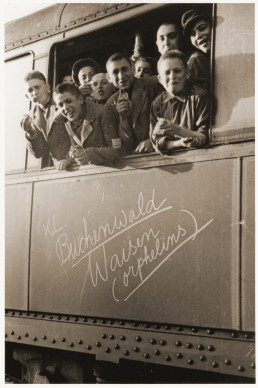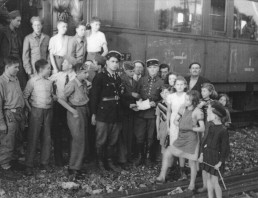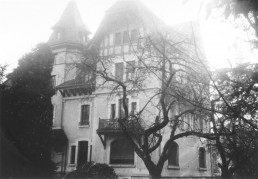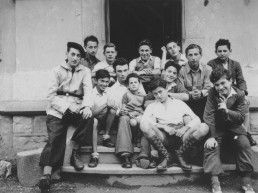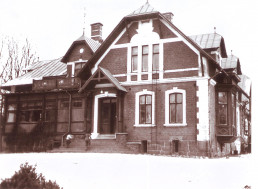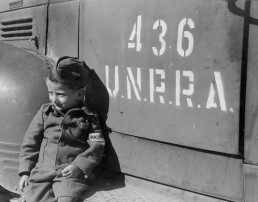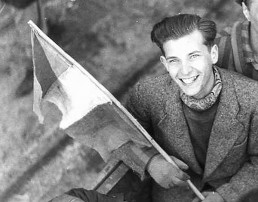Children’s transports after the liberation
The parents and other relatives of the approximately 900 underage survivors of the Buchenwald Concentration Camp had almost all been murdered. Other orphans were brought to Buchenwald from other camps after liberation. For most of them, returning to their homes was unthinkable. The Allies and international aid organizations cooperated in placing them orphanages and care homes. The organization Œuvre de secours aux enfants (OSE) played a special role. Switzerland took in 374 children and young people from Buchenwald, France took in 480, and England took in 250. Many of them wanted to emigrate to Palestine.
Most of the surviving children and adolescents from the Mittelbau-Dora Concentration Camp were liberated in Bergen-Belsen. From there, transports were organized to many countries, including Sweden.
"Where are our parents?" Children and teenagers liberated from Buchenwald at Weimar's main station on a train to Écouis (France), 1 June 1945.
Jozef Dziubak, a 17-year-old Jewish boy deported from Poland, writes in a mixture of German and Yiddish on one of the train cars, “Where are our parents? You (Nazi) murderers.” The train carried more than 400 liberated children and young people to France.
(Buchenwald Memorial)
"Orphans.” Liberated teenagers on their way to a children's home in Écouis, June 1945.
Due to the acute clothing shortage in the liberated camp, the US liberators had dressed some of the children and young people in Hitler Youth uniforms. In France, their train was attacked because they were mistaken for Nazis. The inscriptions on the wagons “K.L. Buchenwald” and “Orphans” served to protect the passengers. At one stop, the boys crowded to the window. Jacques Rybsztajn (second from left) and Arthur Fogel (bottom right) can be seen in this photo.
(United States Holocaust Memorial Museum)
Jewish teenagers with a Star of David flag before their departure from the liberated Buchenwald camp, 5 June 1945.
The two girls Yetti Halpern Beigel (left) and Martha Weber (right) were prisoners at the Bergen-Belsen Concentration Camp. After liberation, they were sent to the Buchenwald DP camp for medical treatment. Together with an unnamed youth from Latvia (center), they were photographed shortly after their departure for France. The girls planned to continue their journey to Palestine.
(Photo: James E. Myers, Buchenwald Memorial)
Arrival: At the Écouis train station, the children and teenagers are welcomed by the authorities, 5 June 1945.
After the train ride, they were welcomed by staff members of the aid organization for Jewish children, OSE. Most of the children and young people remained in France until 1947/48.
(Buchenwald Memorial)
A Swiss newsreel reports on the arrival of the "Buchenwald Children," 29 June 1945.
Rabbi Herschel Schacter accompanied the children and young people on their trip from Buchenwald to Switzerland. Among the children seen in the reel is the four-year-old Joseph Schleifstein. When the “Buchenwald children” arrived in Switzerland, the authorities and the press were surprised at the ages of some of them. The humanitarian aid operation was to have brought only children and adolescents up to 18 years of age to Switzerland, but there were also many homeless young adults who needed a perspective for the future.
(Schweizerisches Bundesarchiv)
"Buchenwald children" in Geneva, 1945/46.
The young people in the OSE homes were not only nursed back to health, they also learned trades in order to be able to build new lives for themselves. Pictured in this group photo in front of the Hôme de la Forêt in Geneva are Gert Silberbard, Gilles Segal and Norbert Bikales.
(United States Holocaust Memorial Museum)
New accommodations in Switzerland: Hôme de la Forêt in Geneva, 1945/46
The children and young people from Buchenwald who were taken in by Switzerland were housed in various orphanages and care homes. In Geneva, the Hôme de la Forêt was made available, and the relief organization OSE (Oeuvre de Secours aux Enfants) provided care.
(United States Holocaust Memorial Museum)
"It was a great effort to bring us back to life." Account by Shraga Milstein on the transport to Sweden, February 2021.
In the fall of 1944 when he was 11 years old, Shraga Milstein was deported from a forced labor camp in Poland to the Buchenwald Concentration Camp, along with his younger brother and father. His father died there, and the brothers were separated in January 1945 when Shraga was transferred to Bergen-Belsen. Both brothers survived and were taken to Sweden in the summer of 1945 with a group of other children who had survived the camps.
(Buchenwald Memorial)
After liberation
Buchenwald DP camp and Kibbutz
In the course of World War II, the Germans deported several million people to the German Reich.
Return home
The liberated children and adolescents wanted nothing more than to return home to their families.
